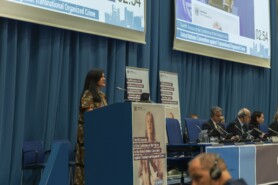Posted on 05 Apr 2018
The consequences of organized crime and violence in cities affect millions worldwide. Rankings of urban crime from Mexican and Brazilian think tanks show that many of the most violent cities in the world are not in war zones, as one might expect, but in Latin America, the Caribbean, the US and southern Africa.
Data from the Small Arms Survey suggests that in 2015 more people died as a result of crime and violence in Brazil than in Syria and Iraq combined. In many cases, most such deaths occur in cities. Research shows that residents of highly violent parts of Los Angeles have the same degree of post-traumatic stress disorder as soldiers returning from service in Iraq. These challenges were among the critical issues addressed at the Habitat III summit in 2016 (the UN Conference on Housing and Sustainable Development), and they are part of the operational dimension of achieving the 2030 Agenda for Sustainable Development.
The political power of organized crime has also become more apparent in recent years, and this has been well documented in regions such as North Africa, the Sahel, and Central and South America. In the contexts of dysfunctional institutions and weak state-society relations, crime groups infiltrate and influence local and national political systems to serve their needs and, in the process, undermine institution building, urban safety and development efforts supported by national governments, municipal authorities and international donors.
Furthermore, conflict, chronic violence and insecurity in cities look set to grow. The confluence of the well-known stress factors of population growth, rapid urbanization, climate change and the diffusion of power (away from states) will find violent expression in cities and overpower existing conflict-management institutions and systems, both formal and informal.
Until now, many city policies have emphasized repressive approaches, whereby the authorities crush organized crime and violence through law and order or a ‘war on drugs’. Other urban safety specialists have focused on modifying the built environment to make cities safer. One example is the way some city authorities have changed traffic management from a system of traffic lights to roundabouts in an attempt to reduce robberies and carjackings.
But, given the explosion of violence and insecurity in many cities, structural modifications to the urban environment must surely be only one part of the solution. Securitized and militarized approaches, meanwhile, have proven largely ineffective in reducing violence and crime. Approaches that are integrated across sectors and work at different levels, however, have seen positive results. Violence-reduction interventions in neighbourhoods of Medellín, Colombia, are a good case in point.
A new policy framework
With this in mind, is it time to expand the policy toolbox available to authorities to fight crime as a political issue? Reframing the challenge of organized crime as a political, as opposed to a criminal issue enables city leaders to explore beyond the default policy choice of legal and security instruments, and strengthen the case for integrated approaches to violence reduction and crime prevention. Conflict prevention and peacebuilding practice in particular may be an effective new strategy to help reduce urban violence.
In government and diplomatic circles, conflict prevention and peacebuilding are often understood as things the UN implements before or after interstate or civil wars. They are also understood to involve an interventionist modus operandi imposed on countries. More recently, however, the UN has coined the term ‘sustaining peace’. This repositions peacebuilding as an activity across all stages of conflict, as a priority for the entire UN System, and as something that not only governments do. This repositioning emphasizes the community-based, collective, inclusive and multi-level nature of peacebuilding, and may assuage the fears of some governments (and mayors) that peacebuilding in the city entails some form of foreign intervention at the urban level.
For seasoned professionals in the fields of conflict prevention and peacebuilding, the current tendency to view dialogue and negotiation with perpetrators of criminal violence as something morally reproachable, illegal or impossible sets us back over 20 years, when the same attitudes were present in relation to so-called liberation movements, insurgents or rebel groups.
There is an increasing understanding that negotiating with today’s urban gangs and criminal groups, is not much different from negotiating with other non-state armed groups, to use the neutral term. In a way, a precedent for the approach to achieve this has been set. Over the last decade, the conflict-prevention and peacebuilding profession has evolved into a global web of facilitators and experts. These networks do the important exploratory work with armed actors to assess if they are ready for talks before more formal peace talks or humanitarian access is possible. Such mediation support has become commonplace and is delivered or supported by many international organizations, governments and NGOs. There is no reason why the same cannot be done to address violent city crime.
The coming tide of conflict and insecurity in cities, and the increasing recognition that urban crime and violence are a political issue, means that those who are serious about peace and development cannot afford to wait for another two decades – until the time of Habitat IV or when countries will assess how they delivered on the 2030 Agenda.
For many urban safety professionals, there is still the perception that conflict prevention and peacebuilding are untested at the city level. It is now time to walk the talk and translate the UN’s new policy frameworks into action. In urban contexts, this means providing mediation support to not only mayors and community leaders, but also to the perpetrators of violence who shape conflict dynamics. Such mediation support can become a dedicated resource to help facilitate negotiated exits from crime. It will also better protect the facilitators of city-level peace charters by creating the political space needed to advance them.
Those willing to lead have much work to do and many places to start, but they should be reassured that effective approaches to combating crime as a political issue are readily available.



